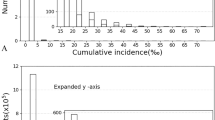Abstract
Human exposure to man-made radiation sources is largely due to diagnostic X-ray examinations, and the overall effect depends on the frequency and close of every single procedure. This paper deals with the evaluation of the frequencies of different types of examinations. As the method of investigation in the former German Democratic Republic (GDR) the consumption of X-ray films combined with the statistical registration of all examinations in 3 of 15 districts of the GDR was used for the basic estimation. In former West Germany (FRG) we used data from the cost-covering institutions and from the diagnosis and therapy index of a commercial data bank. As a result in the GDR we discovered, for 17 million people. 13 million examinations, plus .5 million photofluorographs of the lung and 2.5 million dental films. In the FRG the frequency was, for 65 million people, almost 99 million examinations, including 17.5 million dental films. The most frequent X-ray examinations in both parts of the country involve the skeletal system, followed by examinations of the lung. In Germany the examination frequency is high despite the rather broad use of alternative diagnostic methods. A more strictly controlled indication could reduce the number of examinations without loss in quality.
Similar content being viewed by others
References
NN (1991) ICRP. Recommendations of the ICRP, 1990, ICRP publication 60. Annals of the ICRP 21 (1–3), Pergamon Press, Oxford
NN (1993) Sources and effects of ionizing radiation. UNSCEAR 1993. Report to the General Assembly, United Nations publication E.94.IX.2., Medical radiation exposures, annex C, New York
Arrildt WD (1994) The cost of high-tech care. Radiology 190: 41 A-42 A
Baert AL (1993) Postgraduate radiological education in Europe: EAR working group, Eur Radiol 3: 289
Evens RG (1993) The federalisation of radiology (and medicine) in Europe and North America. Report on the 8th European Congress of Radiology, Vienna (12–17 September 1993)
Evens RG (1993) Self-referral medicine: a growing consensus for action. Radiology 189: 360
Levin DC et al. (1993) Self-referral in private offices for imaging. Radiology 189: 371
Margulis AR et al. (1994) The impact of new imaging technology in reducing health care expenditures. Eur Radiol 4: 1–3
Mettler F et al. (1993) Use of radiology in US. General short-term hospitals: 1980–1990. Radiology 189: 377
Parker RG (1993) The cost-effectiveness of radiology and radiologists. Radiology 189: 363
NN (1986) Gesellschaft für med. Radiologie der DDR: Konzeption “Stand und Perspektive der diagnostischen und interventionellen Radiologie in der DDR”. Berlin
Angerstein W (1989) Die Entwicklung der Radiologie und der Gesellschaft für med. Radiologie der DDR. Radiol Diagn 30: 365–378
Angerstein W (1989) Lexikon der radiologischen Technik in der Medizin (4th edn) Thieme, Stuttgart
Angerstein W, Gursky S, Hegewald H (1987) Grundlagen der Strahlenphysik und radiologischen Technik in der Medizin (4th edn) Thieme, Stuttgart
NN (1989) Anweisung zur Berichterstattung über Untersuchungen mit bildgebenden Verfahren vom 25.04. 1989. Verf. u. Mitt. d. Min. für Gesundheitswesen Nr.3
Angerstein W (1993) Daten über die Röntgendiagnostik in der ehemaligen DDR, Bericht für das Bundesamt für Strahlenschutz. Salzgitter, Berlin
NN (1984) Sammelheft von Arbeiten zur Frage der Indikationsstellung in der Röntgendiagnostik. Radiol Diagn 25: H.4
Bauer B, Tsavachidis C (1993) Häufigkeit von Röntgen- und Alternativuntersuchungen. Röntgenpraxis 46: 25
Bernhardt B et al. (1994) Erhebungen zur kollektiven Dosis bei der Röntgendiagnostik in den alten Bundesländern. Veröffentlichungen der Strahlenschutzkommission (in press)
21.Menzel B (1988) Ermittlung der durch röntgendiagnostische Maßnahmen verursachten Strahlenbelastung und der Wertigkeit ihrer Einflußfaktoren für die Bevölkerungsgruppe “Kinder” in der DDR. Dissertation TH Ilmenau
Umsatzstatistiken 1990–92 des Fachverbandes Elektromedizin. Technik im Zentralverband Elektrotechnik und Elektroindustrie e. V. (ZVEI), Frankfurt
Ertl S et al. (1994) Radiation dose and risk of patients through nuclear medical procedures in the GDR — a comparison of 1978 and 1981. Eur J Nucl Med 9: 241–244
Tautz M et al. (1994) Erhebungen zur Häufigkeit und Altersverteilung sowie der kollektiven Dosis in der Nuklearmedizin der DDR. Veröffentlichungen der Strahlenschutzkommission (in press)
Author information
Authors and Affiliations
Additional information
Correspondence to: W. Angerstein
Rights and permissions
About this article
Cite this article
Angerstein, W., Bauer, B. & Barth, I. Frequency of X-ray examinations in former East- and West Germany: methods and results. Eur. Radiol. 4, 561–565 (1994). https://doi.org/10.1007/BF00226830
Received:
Revised:
Accepted:
Issue Date:
DOI: https://doi.org/10.1007/BF00226830




